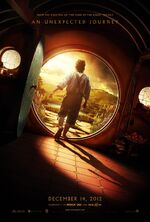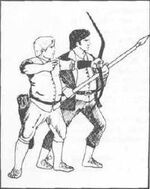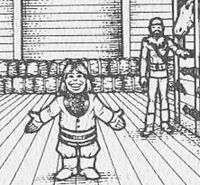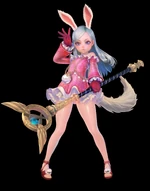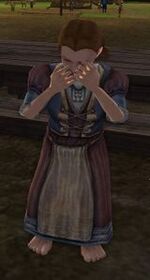It is an undeniable fact that J.R.R. Tolkien has had an immense influence on popular culture today. While Tolkien did not invent the fantasy genre, he pioneered it. Nearly every work of fiction, in any medium, can trace some part of their lineage back to Middle Earth.
Today, in celebration of Hobbit Day, I’m tracing one small aspect of Tolkien’s effect on the video games industry by walking through the History of Hobbits of games in the present day.
This is by no means a definitive list or chronicle of hobbits in games, and I am no Tolkien expert. So if you have a favorite diminutive hero or some keen/corrective insight into the state of Shire-folk in games, chime in below in the comments!
Click for more Hobbit Day celebrations!
Fantasy Game Origins[]
What better place to start than the “Kevin Bacon” of video games: Dungeons & Dragons. Nearly every game can trace its history in some way to the tabletop RPG that still defines the genre. While few remember the earliest edition of Dungeons & Dragons, the original manual, published in 1974, featured hobbits as a playable race. For legal reasons, the name was changed to “Halfling”, another, albeit rarely, used name for hobbits in The Lord of the Rings, which is still used today.
The little-folk shared many, if not all, of the characteristics of Tolkien’s hobbits. Like their predecessors, they were short, chubby, curious, lived underground and had hairy feet. They also had penchant for thievery. This latter trait may actually diverges from Tolkien’s text. While one could argue Bilbo “stole” the One Ring from Gollum, there is little evidence to suggest thievery was rampant amongst the hobbit community.
Nevertheless, the Dungeons & Dragons version of hobbits established a trend that continues to the day. The 4th edition of Dungeons & Dragons, published in 2008, still features Halfling as a playable race. While much has changed in their appearance, they still maintain bonuses to dexterity and thievery, a mainstay of the race since Gary Gygax and Dave Arneson created the game nearly fifty years ago.
Hobbits in Early Fantasy Games[]
While Dungeons & Dragons brought hobbits to tabletop gaming, it was Ultima and other related games that took the fantasy genre, and hobbits, into the digital game space. Published in 1981, Ultima, along with w:c:baldursgate and Wizardry, birthed fantasy RPGs as we know them today. The game also featured the not-so-cleverly-named Bobbits, short and merry creatures that exhibit a contemplative and serene attitude similar to their Tolkien progenitors.
In 1988, the film ‘’Willow’’ released and quickly became a cult favorite. After its box-office success, two video game tie-ins, some of the first, were developed for the arcade and the NES. The games feature Willow, the hobbit-like “Nelwyn” from the film. This version of “hobbit” draws more on The Legend of Zelda than The Lord of the Rings. In the NES version of the game, Willow can wield magical powers, a trait never quite acquired by true hobbits.
The Halflings of Might and Magic series, first published in 1991, may also wield magic when playing as a mage - again, a carry-over from Dungeons & Dragons. The race is also depicted as more fragile and vulnerable than the others, losing some of the sturdiness Tolkien imbued in the characters.
1999’s Everquest and 2001’s Arcanum each featured halflings as well. While Arcanum’s halflings maintained the traditional D&D version of thieving and dextrous hobbits, Everquest adhered closer to Tolkien’s lore, giving the creatures hairy feet and a love of travel. They also maintained their strong constitution and joviality. Like hobbits in other early fantasy games, they too could fill many class roles and had the ability to move quietly.
Never Winter Nights, published in 2002, kept the thieving-hobbit trope going. In some ways, 2007’s Vanguard followed suit, giving halflings the ability to quickly reduce “agro”, giving them a sort of “vanish” ability. They were also a generally peaceful people, very much like Tolkien’s hobbits.
Hobbits Today[]
For some reason, the hobbit or halfling has a playable race as largely vanished from modern fantasy games. The few examples of hobbit-like creatures maintain only a few similarities with the hobbits of Tolkien’s world.
World of Warcraft’s Gnomes share their stature with hobbits, but little else. Masters of technology, the silly race of Azeroth dwellers, have more in common with garden-gnomes than Hobbits.
TERA and Guild Wars 2 feature hobbit-like races in the Elin and the Asura respectively. However, like Gnomes, the Asura are conniving masters of mechanical constructs. The all-female Elin appear part-animal but at least maintain a connection to nature established by early hobbit fiction. Similarly, the Yordles of League of Legends appear furry and many favor technological creations as tools. However, they do exhibit the classic hobbit trait of friendliness.
The Future of Hobbits[]
It appears that Tolkien’s hobbits have vanished from games, which actually makes some sense. With the rise and dominance of first-person shooters, making halflings playable is increasingly untenable. Simply put, the camera level for a three-foot creature is too low. Skyrim does not feature playable short-people, possibly because designing a game from that height is just too difficult.
The modern push towards the gritty and realistic has also left little room in the adventure genre for hobbits and halflings. Frodo and his brethren always exhibited kindness and innocence unique to their race. As Gandalf says of Frodo near the end of his journey, “for him struggles for the right must hereafter be waged only on the moral plane.” Looking back on hobbits, game designers may have found them a too peaceful and amicable race to incorporate into their modern games full of grief and suffering.
Hobbits may be on the way out of video games. While we will keep short races in some games, their adherence to Tolkien’s lore may be over. However, with the latest hobbit film releasing this year, we may get a video game revival. In fact, numerous Lord of the Rings video games features hobbits of course, and this trend will undoubtedly continue. Also, on this is Hobbit Day, lets not forget the strong presence Elves have in video games. Have no fear adventurers, Tolkien’s influence on the games industry may never end.


